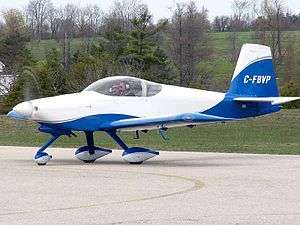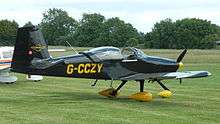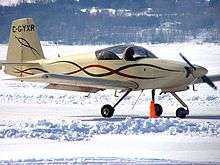Van's Aircraft RV-9
The Van's RV-9 and RV-9A are American two-seat, single-engine, low-wing homebuilt airplanes sold in kit form by Van's Aircraft of Aurora, Oregon. The RV-9 is the tail-wheel equipped version while the RV-9A features a nose-wheel.[3][4][5]
| RV-9 | |
|---|---|
 | |
| Van's Aircraft RV-9A | |
| Role | Kit aircraft |
| National origin | United States |
| Manufacturer | Van's Aircraft |
| Designer | Richard VanGrunsven |
| First flight | December 1997[1] |
| Introduction | 2002 |
| Number built | 1134 (October 2019)[2] |
| Unit cost |
US$44,000–$82,000 |
The RV-9 was built around a newly designed high aspect ratio wing, featuring a Roncz airfoil. It is similar in size and weight to the RV-6 and is externally similar to the RV-6 and the RV-7.[1][6]
Development

The architect of the line of Van's aircraft, Richard VanGrunsven, designed the RV-9 as a departure from the concepts of the earlier RV series. The earlier members of the RV series, starting with the single seat RV-3, were all designed to have light handling, aerobatic capabilities along with fast cruise speeds and STOL capabilities. The RV-9 was designed from the start as a two-place, side-by-side, touring aircraft and as such it forgoes the aerobatic capabilities and the lighter handling for more stability and economy. As such the design horsepower is 118–160 and the prototype was flown with a Lycoming O-235 powerplant of 118 hp (88 kW) as a proof-of-concept for the lower horsepower.[5]
As a result of the lessons learned over the years in producing the first five RV-series designs and the change in role for this aircraft, the RV-9 design incorporated many changes over previous designs.
The RV-9A was the first to use what Van's calls "matched-hole" components in that airframe parts are formed to the required contour and have all the rivet holes precisely located. The assembly jigs normally used to ensure alignment are not necessary and build time is much reduced. Later models, such as the RV-7 and RV-10, use this same manufacturing technique.
Compared to the similar RV-7, the RV-9 has a wing of increased span and higher aspect ratio using a Roncz airfoil. The RV-9 has a slow stall speed, comparable to the Cessna 150, and docile handling suitable for low-time pilots. The cruise speed is a very respectable 167 mph (269 km/h) TAS even with the 118 hp (88 kW) engine.[5]
The RV-9 shares many common parts with the RV-7 and the RV-8, which reduces production costs. Like those aircraft, the RV-9 uses computer assisted design to produce a kit with pre-drilled rivet holes, thus greatly reducing assembly time for the builder.
The RV-9 is unique in Van's aircraft history in that the tricycle gear RV-9A version was flown first on June 15, 2000, three years before the tail wheel version flew. The later conventional landing gear equipped RV-9 was first flown by its designer in 2002. The RV-9A features solid circular spring steel landing gear with the nosewheel mounting tube welded to the engine mount. As in all nose-wheel equipped RV aircraft, the nosewheel is free castering and the aircraft is steered with differential braking. The brakes are mounted conventionally on the rudder pedal toes.
As of October 2019, 1134 RV-9s and RV-9As have been completed and flown.[2]
Specifications (RV-9A with Lycoming O-320)

Data from Van's Aircraft[7][8]
General characteristics
- Crew: one
- Capacity: one passenger
- Length: 20 ft 5 in (6.22 m)
- Wingspan: 28 ft (8.5 m)
- Height: 7 ft 10 in (2.39 m)
- Wing area: 124 sq ft (11.5 m2)
- Empty weight: 1,028 lb (466 kg)
- Gross weight: 1,750 lb (794 kg)
- Fuel capacity: 36 US gallons (136 litres)
- Powerplant: 1 × Lycoming O-320 , 160 hp (120 kW)
- Propellers: 2-bladed fixed pitch
Performance
- Maximum speed: 197 mph (317 km/h, 171 kn)
- Cruise speed: 189 mph (304 km/h, 164 kn) at 75% power and 8000 feet
- Stall speed: 44 mph (71 km/h, 38 kn)
- Range: 710 mi (1,140 km, 620 nmi) at 55% power at 8000 feet
- Service ceiling: 24,500 ft (7,500 m)
- Rate of climb: 1,400 ft/min (7.1 m/s)
- Wing loading: 12.9 lb/sq ft (63 kg/m2)
See also
Related development
Aircraft of comparable role, configuration and era
References
- Van's Aircraft (2008). "Introduction - About RV Kitplanes". Archived from the original on 9 March 2012. Retrieved 2008-09-21.
- Vans Aircraft (October 2019). "First Flights". Retrieved 18 October 2019.
- Downey, Julia: 2008 Kit Aircraft Directory, Kitplanes, Volume 24, Number 12, December 2007, page 78. Primedia Publications. ISSN 0891-1851
- Vandermeullen, Richard: 2011 Kit Aircraft Buyer's Guide, Kitplanes, Volume 28, Number 12, December 2011, page 74. Belvoir Publications. ISSN 0891-1851
- Bayerl, Robby; Martin Berkemeier; et al: World Directory of Leisure Aviation 2011–12, page 125. WDLA UK, Lancaster UK, 2011. ISSN 1368-485X
- Van's Aircraft (n.d.). "Van's RV-9/RV-9A". Retrieved 30 September 2013.
- Van's Aircraft (2008). "Specifications". Retrieved 30 Sep 2013.
- Van's Aircraft (n.d.). "Performance". Retrieved 30 September 2013.